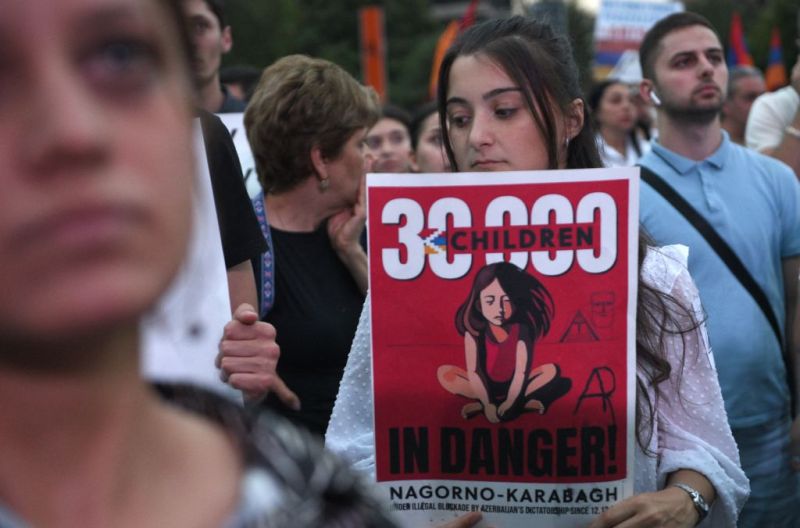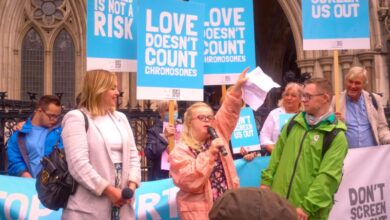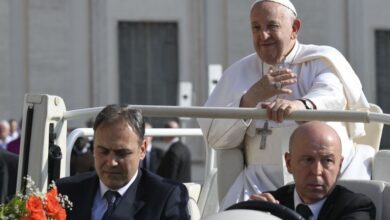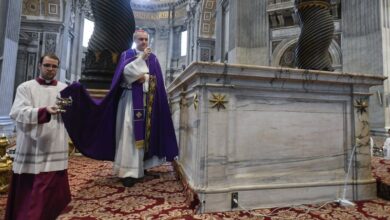Armenian Christians trapped and facing genocide: an explainer
 Demonstrators rally in support of Karabakh to demand the reopening of a blockaded road linking the Nagorno-Karabakh region to Armenia and to decry crisis conditions in the region, in Yerevan on July 25, 2023. / Credit: KAREN MINASYAN/AFP via Getty Images
Demonstrators rally in support of Karabakh to demand the reopening of a blockaded road linking the Nagorno-Karabakh region to Armenia and to decry crisis conditions in the region, in Yerevan on July 25, 2023. / Credit: KAREN MINASYAN/AFP via Getty Images CNA Staff, Aug 9, 2023 / 14:00 pm (CNA).
More than 120,000 Christian Armenians are currently trapped, without food or medicine, behind a blockade of the Nagorno-Karabakh region maintained by the Muslim-majority nation of Azerbaijan.
Former ambassador-at-large for international religious freedom Sam Brownback, who recently returned from a fact-finding mission to Armenia, said Azerbaijan is “strangling” the Christians in the region and that the blockade is the regime’s latest attempt at “religious cleansing.”
“They’re working to make it unlivable so that the region’s Armenian-Christian population is forced to leave, that’s what’s happening on the ground,” Brownback said in June.
Why is Armenia at war with Azerbaijan?
Since 1988, Armenia and Azerbaijan have been fighting over the region of Nagorno-Karabakh, or “Artsakh,” as the Armenians call it.
Though some see the conflict as strictly one over borders, experts have emphasized that religion also plays a central part in the war between Christian Armenia and Muslim Azerbaijan. Armenia wants to retain its hold on Artsakh, while Azerbaijan wants to expel the Armenian Christian population to solidify its hold on the region, according to Brownback.
Azerbaijan is both politically and philosophically aligned with the major regional power, Turkey. Brownback believes Turkish President Tayyip Erdogan has ambitions to reestablish the Ottoman Empire, which committed genocide on Armenian Christians in the early 20th century.
With Turkey’s help, Azerbaijan has blocked the free flow of aid and people in and out of the Christian enclave of Karabakh. Both countries must face consequences for their actions. @POTUS should stand on principle, not diplomatic expediency. #SaveKarabakhhttps://t.co/JJxIwLhG0P
— Sam Brownback (@SamuelBrownback) July 17, 2023
Sandwiched between the Muslim nations of Turkey and Azerbaijan in the southern Caucasus Mountains, Armenia has long been under threat from its larger and more powerful Islamic neighbors.
With Christian roots that go back to ancient times, Armenia has one of the oldest Christian communities in the world.
Both nations were part of the Soviet Union until it fell in 1991. After the Soviets’ collapse, both claimed Nagorno-Karabakh as their own.
The conflict has escalated into outright war multiple times throughout the years, with several unsuccessful truces being unable to keep the peace.
What’s at stake?
According to several experts who have spent time on the ground in Armenia, the Christian community in Nagorno-Karabakh is facing genocide.
“The situation is extremely urgent and existential,” Robert Nicholson, president of the human rights group the Philos Project, said in June.
“This is the oldest Christian nation facing again for the second time in only about a century the possibility of a genocide,” Nicholson added.
Commentators say international intervention is needed immediately to allow food and necessities to get to the Armenians trapped in Nagorno-Karabakh.
What is the blockade about?
In 2020, with the backing of Turkey, Azerbaijan reignited the long-simmering conflict by invading Nagorno-Karabakh. A six-week conflict ended in Azerbaijan seizing control of Nagorno-Karabakh.
The war killed 6,800 combatants, displaced 90,000 people, and left over 100,000 Armenian Christians cut off from the rest of Armenia. A narrow road less than four miles long, called the “Lachin Corridor,” connects Armenia and Nagorno-Karabakh and is the only way to get food and supplies to the Armenians living there.
In December 2022 pro-government Azerbaijanis, ostensibly protesting Armenian environmental violations, began blockading the Lachin Corridor, cutting off all access to aid. In April, the protests ended after Azerbaijani troops, defying warnings from the international community, established a military checkpoint on the road, continuing the blockade.
How is the blockade threatening Christian lives?
Since the start of the blockade in December 2022 the plight of the 120,000 Christian Armenians in Nagorno-Karabakh has steadily worsened.
Lusine Stepayan, project manager at the Catholic relief group Caritas Armenia, told CNA in February that the blockaded population includes 30,000 children, 20,000 elderly people, and 9,000 people with disabilities.
“The blockade of the Lachin corridor has left Nagorno-Karabakh without food, medicine, electricity, or natural gas,” Simon Maghakyan, a Denver-based researcher and human rights advocate, told CNA.
“The situation for the entire population is dire,” Maghakyan said. “They are on the brink of mass starvation. But the goal is psychological terror: to make the indigenous Armenians of Nagorno-Karabakh, who have lived in the region for 2,500 years, feel helpless and hopeless and leave at the first opportunity [when the blockade is lifted] for good.”
What does the pope have to say?
In his Dec. 18, 2022, Sunday Angelus remarks, Pope Francis voiced his worries about the situation in the Lachin Corridor.
“I ask everyone involved to commit themselves to finding peaceful solutions for the good of the people,” the pope said.
“In particular, I am concerned about the precarious humanitarian conditions of the populations, which risk further deterioration during the winter season,” Francis added.
Despite the pope’s words and protests from Armenia, international human rights groups, and the United Nations, Azerbaijan has refused to lift the blockade and in January denied that it exists.
According to the Azerbaijani government, Azerbaijan guarantees the safety of civilians, vehicles, and goods traveling through the Lachin Corridor. In its view, these guarantees include “the prevention of abuse along Lachin Road.”
What are Catholic relief agencies doing?
Catholic Relief Services (CRS), the U.S. bishops’ international aid organization, has been supporting Armenian Christians in Nagorno-Karabakh through financial contributions to Caritas Armenia, the Armenian arm of the international Catholic relief group Caritas.
“After the outbreak of the war in 2020 CRS presence and direct and immediate support came very soon, from the very first days of the war,” Stepayan said.
The agency provided emergency humanitarian relief, financial support, and capacity-building support to Caritas Armenia.
Caritas International has also supported Caritas Armenia’s fundraising and emergency appeals.
What can the U.S. do?
Despite the blockade and preceding armed conflict, the U.S. has continued to give Azerbaijan millions of dollars in economic aid, according to U.S. State Department numbers. The U.S. sent more than $ 13 million in aid to Azerbaijan in the 2022 fiscal year.
France and the European Union also continue to give Azerbaijan tens of millions of dollars in economic aid in recent years.
This leads many to believe that international pressure can resolve the situation.
Former ambassador Brownback has called on the U.S. government to invoke Section 907 of the Freedom Support Act of 1992.
Section 907 mandates that U.S. aid and funding “may not be provided to the government of Azerbaijan until the president determines, and so reports to the Congress, that the government of Azerbaijan is taking demonstrable steps to cease all blockades and other offensive uses of force against Armenia and Nagorno-Karabakh.”
Despite continued conflict over Nagorno-Karabakh, the U.S. has waived this restriction for more than 20 years.
What’s next?
The U.S., European Union, Russia, and several other nations helped to facilitate several peace talks between Armenia and Azerbaijan in May and June.
In the span of those two months, leaders from the warring nations met in Washington, D.C.; Moscow; Brussels; Chisinau, Moldova; and Ankara, Turkey, leading many to be hopeful that a diplomatic, peaceful solution could soon be on the horizon.
Though Armenian Prime Minister Nikol Pashinyan has recognized Nagorno-Karabakh as Azerbaijani-sovereign territory, he continues to advocate for the rights of the Armenians trapped in the region.
Thus far there have been no official agreements or resolutions signed by either nation.






